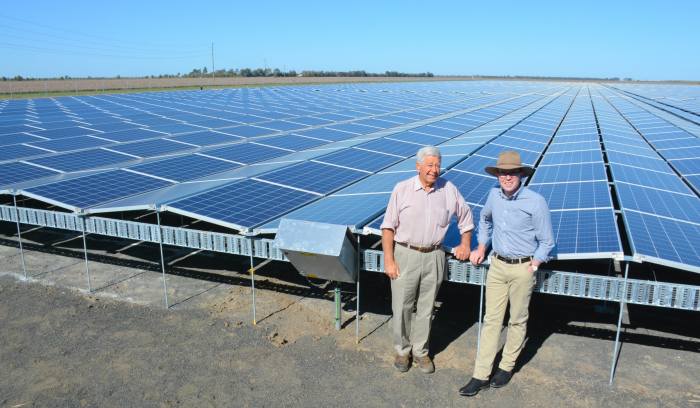
Solar powers on in Boggabilla | Image source: Adam Marshall
Boggabilla, a small town in the far north of inland New South Wales, has been put on the map with a recently completed privately funded solar farm.
Comprised of 16,000 solar panels, four inverters and two sub-stations, the 3.6MW installation covers 4 hectares of a farm owned by the Mailler family. The panels have been lifted well above ground level to address flooding concerns and optimally positioned using technology created by the Maillers.
When operating at peak output, the facility generates enough electricity to power Boggabilla (population: ~626) seven times over. The plant is expected to generate approximately 8,000 megawatt hours of clean energy a year.
The project was financed by local business, agricultural producers, and mum and dad investors.
Member for Northern Tablelands Adam Marshall recently visited the solar farm and said the project was an example of how solar installations of this nature can be effectively executed on a small plot of land and harness local knowledge.
“The facility provides a compelling blueprint for further investment of small-scale renewable development in communities across the Northern Tablelands.”
Mr. Marshall said while investors should see a good return through electricity exports to the grid, now was the time to trial peer-to-peer trading in the region.
“By allowing locals to sell power directly to each other – mum and dad power producers will see a better return on their investment, and enhanced competition will drive down power prices.”
The commissioning of the solar farm has provided a massive boost to the area’s solar capacity. Clean Energy Regulator data indicates there are just 35 small-scale solar power systems in the 2490 postcode, with a collective capacity of 211 kilowatts.
Boggabilla is part of the Moree Plains Shire, which is also home to a much larger PV power station, Moree Solar Farm. Situated around 10km south of Moree, it’s a 56MW photovoltaic solar plant that generates enough electricity to supply the equivalent of around 24,000 homes, while avoiding 95,000 tonnes of greenhouse gas emissions a year. Moree Solar Farm commenced operations last year.
Moree Plains Shire Council strongly supports the development of solar projects within its boundaries.
“We love solar out here on the plains because we get so much sunshine,” said Moree mayor Katrina Humphries earlier this year.
Moree is known locally as big sky country, and takes its name from a Kamilaroi word believed to have ‘rising sun’ among its meanings.

 RSS - Posts
RSS - Posts



Speak Your Mind